Many radio amateurs consider a directional antenna at 7MHz to be a difficult goal requiring a tall antenna tower and a lot of aluminum.
If there is enough space, another solution is offered in the form of a 'forgotten' 2-element inverted Vee beam. Many radio amateurs know and use the classic inverted Vee antenna. Everyone who has made it will probably confirm that it is an easily manufacturable and functional antenna. Adding one element creates a two-element fixed directional antenna.
Video: test 2-elEMEnt inverted V beam 7MHz (40m)
The antenna can be set up by a single person and the price is very low. The video shows the first RX test after completion. The comparison took place in the afternoon hours. The second antenna is a 1/4 vertical on a dimensional metal roof, which works very well. It can be heard that DL/SP/I stations are significantly stronger on the beam, while UA almost unchanged - which is caused by the front-to-back ratio of the antenna. Of course, a significant difference is also caused by different polarization and vertical radiation angle of the antennas. Also note the change in background noise level.
Test in CQ WW SSB contest
The antenna also passed a demanding test in the form of CQ WW SSB contest. With 100W, it helped break through pile-ups, for example on KP2, VP2M, VP5, YN, 6Y, KP4, V2, HK, PJ4, etc. Laci OM/HA6NL worked 17x YV with it one ordinary morning. From here Location it is the most difficult direction completely covered by mountains…
RX comparison of 2el. inv.V beam 7MHz and 1/4 vertical antenna

Dimensions of 2el. inverted Vee beam antenna on 7MHz
Antenna construction
The antenna can be constructed in two ways: as a suspended or carried. In the first case, the support cable needs to be stretched in the direction of radiation. The carried antenna has the tops of the elements attached to supports. It is only on individual preferences which method is more suitable. An important factor is the height above the ground. For me, it is 13m, which is about the minimum.
Description of 2-element inverted V beam 7MHz antenna can be found in the publication 73 Vertical, Beam and Triangle Antennas (MFJ, 1992). The drawing also inspires a way to switch the direction, but I have not tried this option.

Simulation of 2-element inverted Vee beam antenna on 7MHz with a top height of 13m

Calculated course PSV antennas
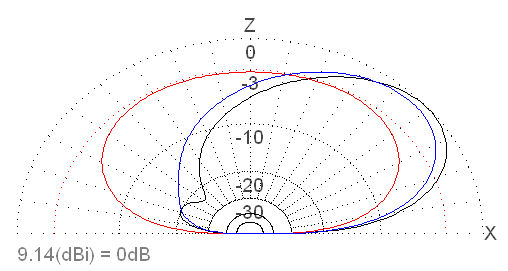
Comparison of radiation patterns of three antennas at 7MHz at the same height: half-wave dipole (red), 2-element inverted V beam 7MHz (blue), moxon antenna (black)
Simulation of 2-element inverted V beam 7MHz in MMANA program shows these results: gain 3.3dBd, F/B ratio 9.8dB and impedance at resonance close to 50ohm. The popular HB9CV has better properties (gain 4.1dBd and F/B approx. 20dB), but is it feasible?
I realized the carried 2-element inverted V beam 7MHz using combined dural-glass-fiber poles. First, we make the radiator with a center insulator and connection to the coaxial cable. We attach it to the pole, raise it, and anchor the pole. The ends of the radiator are raised by a thin climbing rope and stretched to the attachment points so that the inverted Vee at the top has an angle of at least 100°. We fix the wire to the director on the second pole, raise it, and anchor it.
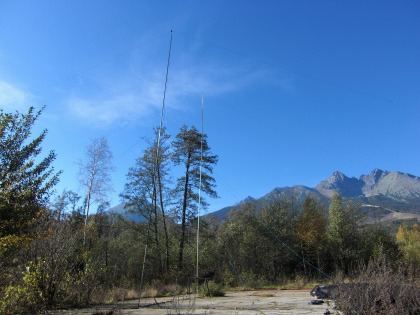
2-element inverted V beam 7MHz after completion
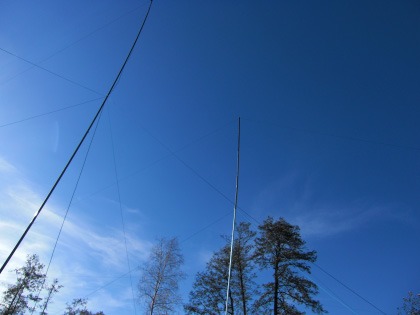
Detail of poles and anchors of 2-element inverted V beam 7MHz. In the case of two or more people during construction, the system's stability can be increased by adding a delineating 6.22m rope to the antenna tops and anchor ropes from the pole tops in front of and behind the antenna
Setting up 2-element inverted V beam 7MHz
The advantage of this relatively small height is that we can fine-tune the antenna directly from the ground, just by loosening the arm of the element. The length of the elements is adjusted fundamentally to preserve their function in the antenna, i.e. the director is 4.8% shorter than the radiator.. Tuning is not complicated, but it is a bit laborious. It is a very useful helper antenna analyzer.
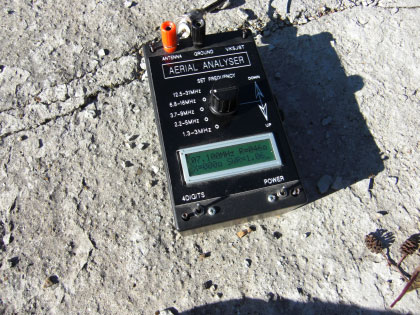
Measuring 2-element inverted V beam antenna at 7100kHz, Z=46ohm +/-j0ohm
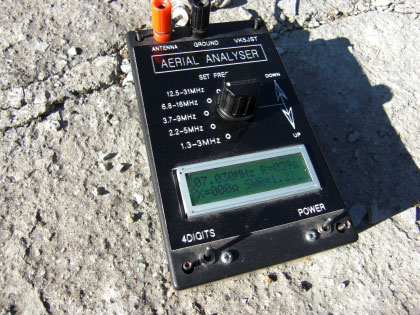
Measuring 2-element inverted V beam antenna at 7030kHz, Z=39ohm +/-j0ohm
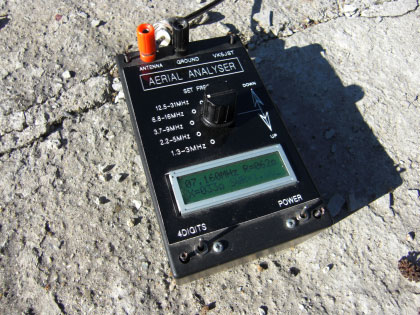
Measuring 2-element inverted V beam antenna at 7160kHz, Z=62ohm +/-j33ohm
Possible improvements for 2-element inverted V beam 7MHz
There are several possibilities for improvement. It is advisable to include in the feeding point balun Probably the most valuable is W1JR balun, which can be easily made at home in good quality and properties. Another option is the already mentioned change of antenna direction by extending the director to the reflector. It also offers the addition of another element and the creation of an even more profitable antenna.
2-element inverted V beam 7MHz made my favorite from the 7MHz band. Won't you join?
